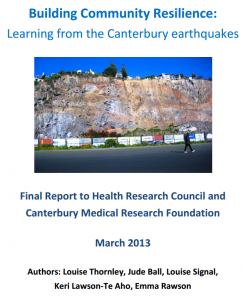
Building community resilience: Learning from the Canterbury earthquakes: Final report to Health Research Council and Canterbury Medical Research Foundation
Thornley, L., Ball, J., Signal, L., Lawson-Te Aho, K., & Rawson, E. (2013, March). Christchurch: Quigley and Watts.
“Community participation is vital in disaster planning, response, and recovery. Around the globe, disaster experts agree on the need to increase the resilience of communities. But limited research exists into what increases a community’s ability to adapt after a disaster, especially from the perspective of post disaster communities themselves.”
They found four common influences on community resilience:
- Pre-existing community connectedness and community infrastructure
- Community participation in disaster response and recovery
- Community engagement in official decision-making, and
- External support from organisations and authorities outside the community
They conclude with: “Our research sheds light on how to foster strong, engaged communities – both in a disaster context and under ‘normal’ conditions. Key strategies include community-led action (e.g. community development, iwi/tribal development and health promotion), understanding communities and their complexity, and building strong partnerships between communities and authorities. Our work also indicates why it is important to build strong, engaged communities – because these communities cope better with crises. However, communities need to be sufficiently resourced and enabled to carry out their vital role.”
Find the Report here
